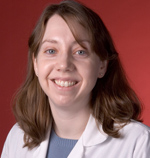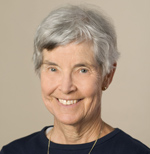Study shows no higher risk of breast cancer for women who don’t have BRCA mutation but have relatives who do
Study shows no higher risk of breast cancer for women who don’t have BRCA mutation but have relatives who do
In the largest study of its kind to date, Stanford University School of Medicine researchers have shown that women related to a patient with a breast cancer caused by a hereditary mutation — but who don’t have the mutation themselves — have no higher risk of getting cancer than relatives of patients with other types of breast cancer. The multinational, population-based study involving more than 3,000 families settles a controversy that arose four years ago when a paper hinted that a familial BRCA mutation in and of itself was a risk factor.
 “The results are encouraging and reassuring,” said Allison Kurian, MD, assistant professor of oncology and of health research and policy and first author of a paper that appears online Oct. 31 in the Journal of Clinical Oncology. She and her colleagues — including senior author Alice Whittemore, PhD, professor of health research and policy — said their findings support the current practice of advising so-called non-carriers that there is no increase in risk attributable to their family-specific BRCA1 or BRCA2 mutation.
“The results are encouraging and reassuring,” said Allison Kurian, MD, assistant professor of oncology and of health research and policy and first author of a paper that appears online Oct. 31 in the Journal of Clinical Oncology. She and her colleagues — including senior author Alice Whittemore, PhD, professor of health research and policy — said their findings support the current practice of advising so-called non-carriers that there is no increase in risk attributable to their family-specific BRCA1 or BRCA2 mutation.
The study doesn’t dispute that women who have relatives with any type of breast cancer have a greater risk of contracting the disease compared to those with no cancer-stricken relatives.
 Mutations in the BRCA1 and BRCA2 genes are strongly associated with the development of breast or ovarian cancer: Carriers face a five- to 20-fold increased risk of developing these cancers and are usually subject to intensive screening and risk-reduction strategies. Female relatives who are tested and found not to carry the family-specific mutation have historically been advised that their cancer risks are the same as those of other relatives of breast cancer patients (that is, slightly higher than women in the general population).
Mutations in the BRCA1 and BRCA2 genes are strongly associated with the development of breast or ovarian cancer: Carriers face a five- to 20-fold increased risk of developing these cancers and are usually subject to intensive screening and risk-reduction strategies. Female relatives who are tested and found not to carry the family-specific mutation have historically been advised that their cancer risks are the same as those of other relatives of breast cancer patients (that is, slightly higher than women in the general population).
The field was shaken up when a 2007 Journal of Medical Genetics paper showed that women who tested negative for a familial BRCA mutation had a two- to five-fold increased risk of developing breast cancer. Several other studies found a two-fold risk for non-carriers who had a relative with the mutation, prompting some to wonder whether ongoing breast cancer surveillance should be recommended for these relatives.
“Our clinic received many calls about it — it was widely read by people in the field and by patients,” said Kurian, a practicing oncologist whose research focuses on breast cancer risks across populations. The study, and the notion that additional screening for non-carriers might be warranted, caused both concern and skepticism among cancer geneticists. “It went against what was being done.”
The 2007 study had compared relatives of BRCA carriers with women in the general population, and Kurian and her colleagues thought this might have created high estimates of the non-carriers’ risk. For one reason: Women in a family with a known BRCA mutation are more likely to receive more intensive screening, and thus be more likely to be diagnosed with breast cancer than women in the general population.
And also, said Whittemore, “First-degree relatives of breast cancer patients are themselves at higher risk than women in the general population. So some reports of higher risk among non-carriers, as compared to risk in the general population, may have been an inappropriate comparison of apples and oranges.”
The researchers sought, then, to compare cancer risk in non-carriers with a control group of relatives of cancer patients without the mutations. For the study they used data from population-based cancer registries provided by co-investigators from the Cancer Prevention Institute of California, the University of Melbourne in Australia and the University of Toronto in Canada to look at 3,047 families. Of the total, 160 families had BRCA1 and 132 had BRCA2 mutations.
When comparing the groups of relatives, they found no evidence of an increased breast cancer risk for non-carriers compared with the control group. The authors note that this finding supports “evidence-based practice guidelines [that] currently recommend that non-carriers be screened according to standard protocols for their age and other risk factors.”
The findings should put to rest questions about risk based on a familial BRCA mutation. But Kurian added, “It’s important for patients and clinicians to remember this doesn’t rule out other risk factors, which might increase a non-carrier’s probability of getting breast cancer.”
Other co-authors include Gail Gong, PhD, senior research scientist; Esther John, PhD, senior research scientist at the Cancer Prevention Institute of California and consulting professor of health research and policy at Stanford; programmers David Johnston and Anna Felberg; and Dee West, PhD, emeritus professor of health research and policy at Stanford and senior advisor at the CPIC.
Funding came from the National Cancer Institute, National Institutes of Health, Cancer Care Ontario, CPIC and the University of Melbourne, and through cooperative agreements with members of the Breast Cancer Family Registry and principal investigators.
* Information about Stanford’s Department of Health Research and Policy, which also supported this work, is available at http://hrp.stanford.edu/
** Stanford University Medical Center integrates research, medical education and patient care at its three institutions – Stanford University School of Medicine, Stanford Hospital & Clinics and Lucile Packard Children’s Hospital.
*** The above story is adapted from materials provided by Stanford University School of Medicine
________________________________________________________________



















